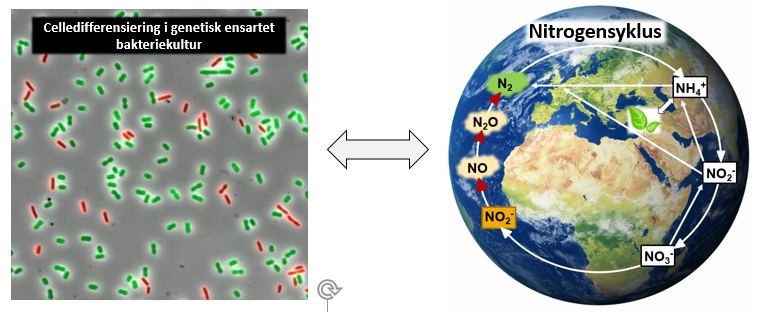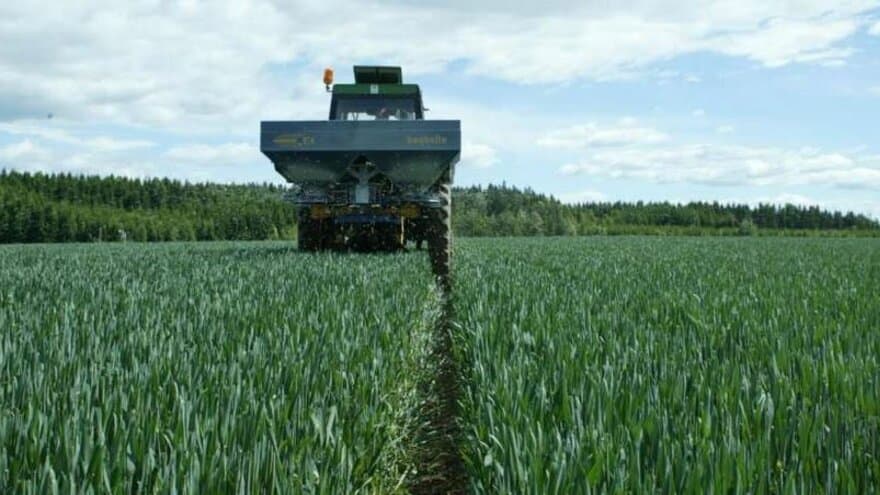Extensive use of chemical fertilizers in agriculture is resulting in emissions of nitrous oxide – a potent climate gas. Soil bacteria are essential in this context since they both produce and convert nitrous oxide!
Ever since the early days of modern agriculture, we have enhanced plant growth by adding nitrogen (N) to the soil. Today our generous application of chemical fertilizers has resulted in increased emissions of nitrogen gas (N₂), dinitrogen oxide/nitrous oxide (N₂O) and nitrogen monoxide (NO).
The research project DEPHEND is designed to improve our understanding of the microbial processes driving these emissions.
Soil microbes are nitrogen managers
Metabolism of microorganisms drives the conversion of nitrogen and determines the emission ratio between the respective nitrogen gases.
Emission ratio is important, because while N₂ is harmless and constitutes almost 80% of the air we breathe emissions of N₂O and NO impact the environment in different ways. Nitrogen monoxide (NO) is unstable and reacts easily with oxygen species in the troposphere.
This results in the formation of ozone, which we do not want. Despite its colloquial name, laughing gas, N₂O is no laughing matter in an environmental context. On the contrary, N₂O is the most important destructor of stratospheric ozone and a greenhouse gas almost 310 times more potent than CO₂.
Denitrification – source and sink of N2O
Linda Bergaust’s research mainly involves studying the physiology of prokaryotes, primarily bacteria, but also archaea, which reduce nitrate and nitrite to N₂ via NO and N₂O, using a set of four enzymes. This occurs as a response to limited access to oxygen and is a form of anaerobic (oxygen-free) respiration.
The process is called denitrification, and organisms that have this ability are “everywhere” and in high numbers. In a global perspective, denitrifying prokaryotes are the main producers and consumers of N₂O in soil.

Variable oxygen availability creates challenges
Denitrifying bacteria prefer oxygen for respiration, but if changes occur in their access to oxygen, e.g. when the soil becomes water saturated, they must decide how to better invest their often poor energy reserves.
If their access to oxygen decreases or ceases, these organisms can use nitrogen oxides (nitrate, nitrite, NO, N2O) instead of oxygen for respiration purposes, so that they conserve their energy by forming adenosine triphosphate (ATP). ATP is the cells’ energy currency and acts as a universal energy supplier in all cells and tissues.
However, in order to be able to use the nitrogen compounds, the organisms must have the enzymatic apparatus needed and they need to form it before oxygen disappears completely. This is called synthesizing enzymes – and it is an energy-intensive "investment" which, in the short term, can be detrimental to the organism’s growth.
The energy economy dilemma of prokaryotes
If soil bacteria are to "believe" that the new, oxygen-deficient conditions are going to last for a while, should they synthesize all the enzymes they need in order to reduce nitrates all the way to N2 and thus ensure the highest possible anaerobic (oxygen-free) growth rate and yield?
On the other hand, should they hold back and be satisfied with synthesizing only part of the denitrification apparatus, along with the consequences that such has on their growth rate, while oxygen is unavailable?
If they are facing a long period of oxygen-depletion, then full investment in denitrification is a good idea, but if the oxygen returns quickly, they will have wasted valuable energy on creating machinery that they no longer need.
On the other hand, if they have only made a minimal investment in order to ensure their survival during short periods of oxygen depletion, they will have an advantage in cases when the oxygen returns quickly. As such, one could say that when oxygen disappears, the bacteria need to make a bet: will the oxygen return quickly, or will the change last for a long time?
Gambling bacteria and N₂O sinks
Some soil bacteria behave precisely in this manner. When they discover that oxygen is about to disappear, all the cells in a culture synthesize the enzyme which reduces N2O to N2. At the same time, only a few invest in the rest of the denitrification enzymes.
At the start of an oxygen-depleted period, some cells will thus grow quickly and both produce and reduce N2O, while the majority of cells will grow slowly and rely on the reduction of small amounts N2O released by the minority.
We say that there has been a cell differentiation and such cultures will be net sinks for N2O under conditions where oxygen availability fluctuates frequently.
At a basic level
DEPHEND is very much a basic research project and the path towards actual implementation of discoveries is a long one. However, the work will be conducted in a context where findings quickly can be tested in systems that are more complex.
This project will combine molecular methods, microscopy techniques, detailed studies of gas kinetics in pure cultures and mathematical modelling.
The aim is to acquire a greater understanding of the mechanisms behind cell differentiation in denitrifying bacteria, its prevalence and implications of NO and N₂O emissions from soil to the atmosphere.
